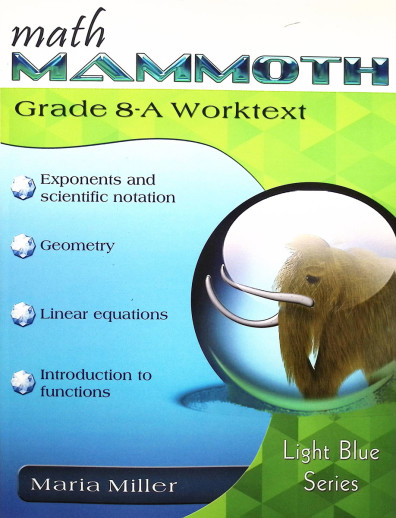We use cookies to make your experience better. To comply with the new e-Privacy directive, we need to ask for your consent to set the cookies. Learn more.
Math Mammoth Grade 8-A Worktext (2024 Edition, Full Color)
This is the first worktext in the mastery based, student independent 8th grade math curriculum by Math Mammoth. There is an included User Guide at the beginning of the worktext to familiarize students and parents with the program. The instruction is written directly to the students in their worktext. Semester A topics include Exponents and scientific notation, Geometry, Linear equations, and Introduction to functions. The worktexts are consumable. 233 pgs, pb. ~Rebecca
It is here! Author, Maria Miller, heard the requests of the people and has developed a Grade 8 Math Mammoth curriculum. This study provides a unique math focus, as it is not a Pre-Algebra program nor a full Algebra 1. The program is broken up into A and B semester Worktexts, a test book, and an answer key for all practice and test problems.
This year of Math Mammoth is for those students who need one more year of the methodology and to build Algebra readiness skills. Not all Algebra 1 skills will be covered in this one-year course, but it will lay a solid foundation for Algebraic concepts. There are options for the path your student takes after this course. Students can follow the CCS guidelines and they would not be repeating any Algebra 1 skills. Students could go directly into a Geometry course and continue from there. Many Algebra 2 courses will have an overview of Algebra 1 concepts, meaning students could jump into an Algebra 2 course with the benefit of that review. If you want students to have a complete Algebra 1 foundation, finding an Algebra 1 course and focusing on the later skills of, polynomials, quadratic equations, rational algebraic expressions, radical algebraic expressions, and inequalities will round out their Algebra skills.
What’s covered in this level:
- Teaches traditional Pre-algebra and Algebra 1 topics.
- Introduction to functions.
- Exponent laws and Scientific Notation.
- Geometric transformations, angle relationships, and volume.
- Graphing and solving linear equations and proportional relationships.
- Irrational numbers, square and cube roots, and the Pythagorean Theorem.
- Solving systems of linear equations (in two variables).
- Statistics: scatter plots and two-way tables.
There are a few materials you will need for this course and many you may already have around your house: tracing paper, a ruler (inches and millimeters), a compass, a protractor, and graphing paper.
Currently, there are no lesson videos available for Grade 8. The hope is they will be produced in the future. ~Rebecca

